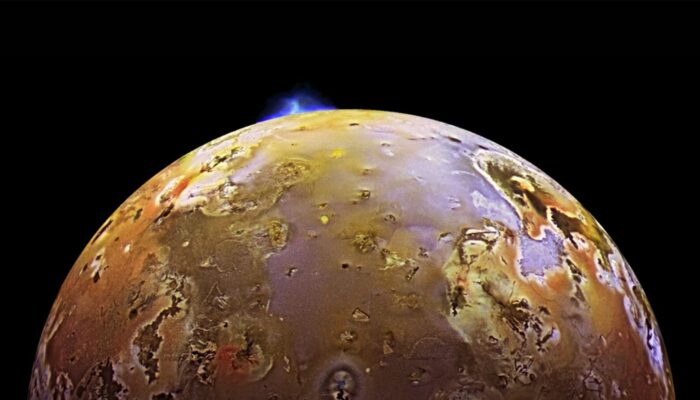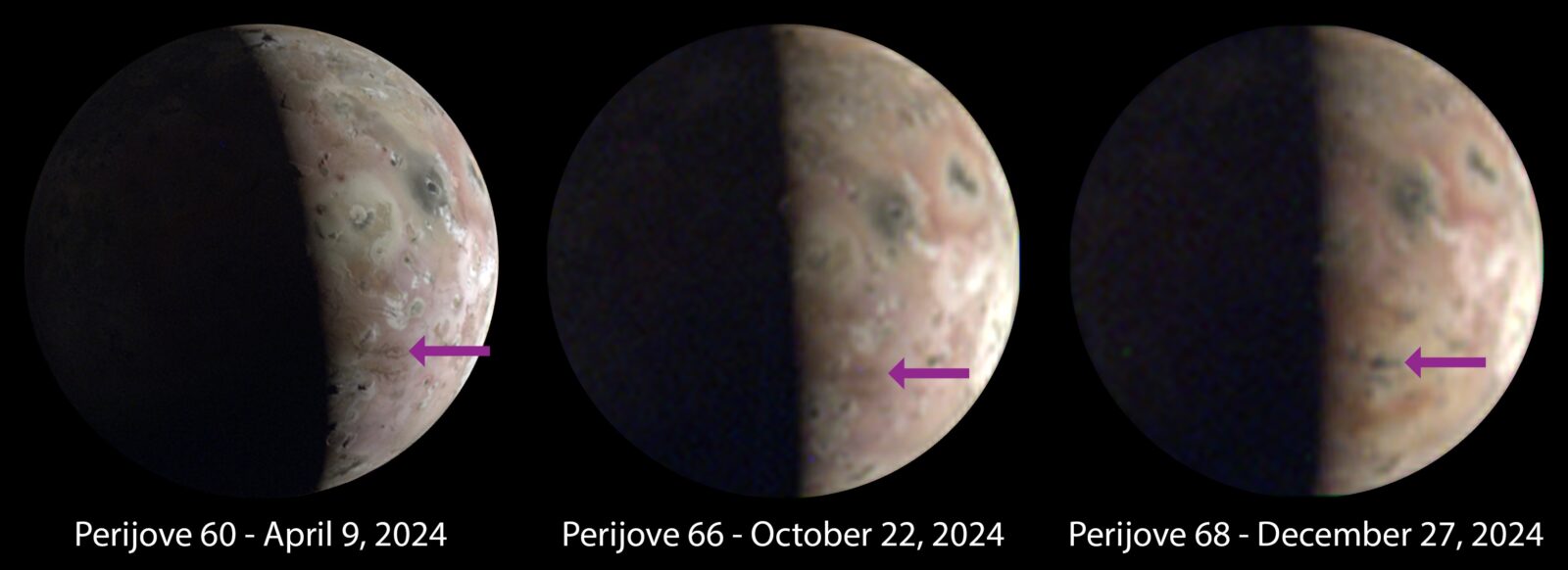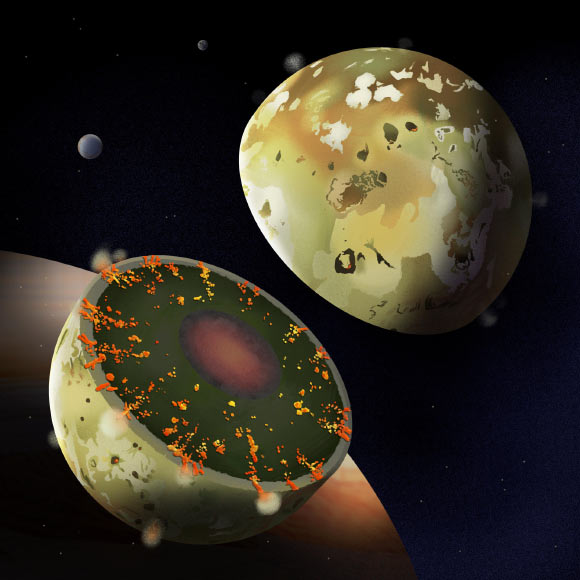
Jupiter’s moon Io is the most volcanically active world in our solar system, with hundreds of volcanoes that constantly erupt on its ever renewing surface. Although Io always points the same side toward Jupiter in its orbit around the gas giant, two other Galilean moons, Europa and Ganymede, pull Io’s orbit into an irregularly elliptical one. Thus, in its widely varying distances from Jupiter, Io is subjected to enormous tidal forces. The tidal forces generate a tremendous amount of heat within Io, keeping much of its subsurface crust in liquid form, seeking any available escape route to the surface to relieve the pressure. Thus, the surface of Io is constantly in a state of renewal, filling in any impact craters with molten lava lakes and creating vast new plains of solidifying rock.
The greatest eruption of our solar system
The interior of Io, according to NASA observations with Juno in 2024, is riddled with magma chambers – large underground pools of molten rock. Scattered all throughout the moon, these magma chambers turn Io into the space equivalent of a giant sponge – filled with holes. But what exactly gives energy to those magma chambers? The answer is once again, Jupiter. The Gas Giant is so big and Io being so close to it ends up deforming because of the tidal interaction. This gravitational influence that one celestial body exerts on another, causes a “tidal bulge” on Io, forcing it to deform.
During Juno’s 68th orbit, the Jovian Infrared Auroral Mapper (JIRAM) instrument, contributed by the Italian Space Agency on board Juno had the chance to observe something extraordinary: the largest eruption ever recorded on Io, that probably matches the largest eruption ever recorded on the Earth.
Designed to capture infrared light (which isn’t visible to the human eye) emerging from deep inside Jupiter, JIRAM probes Jupiter’s weather layer, peering 50 to 70 kilometers below its swirling clouds. Although its mission was originally focused the planet, NASA extended Juno’s mission to also study the moons Io, Europa, Ganymede, and Callisto, finding something extraordinary.
According to Allesandro Mura, a Juno co-investigator from the National Institute for Astrophysics in Rome, the instrument detected an event of extreme infrared radiance — a massive hot spot — in Io’s southern hemisphere.

Images of Io captured in 2024 by the JunoCam imager aboard NASA’s Juno show signif-icant and visible surface changes (indicated by the arrows) near the Jovian moon’s south pole. These changes occurred between the 66th and 68th perijove, or the point during Juno’s orbit when it is closest to Jupiter. (Credit: NASA/JPL-Caltech/SwRI/MSSS Image processing by Jason Perry
“You must remember this is infrared light. Infrared is very good because it is not visible to our eyes, but it gives you the amount of energy, the amount of heat, that the body is releasing. It is very useful for this purpose, because it is able to tell you the energy budget of something”.
Thanks to this data, the researchers were able to measure the total energy and total power of this eruption.
The amount of energy that was released was 300 terawatts – the same amount of energy that the total human civilization uses for one year.
If you want to compare this energy and power with a volcano, this matches very well, for example, with Mount Tambora eruption in 1815, the age of Napoleon. Therefore, this event on Io shows us what happens every 100 years on Earth – a very rare and violent occurrence.
On Io though, eruptions such as this one happen very often, because the previous record for an eruption was set on Io only 20 years ago. “What is even more surprising is that we observed that at the same time, many eruptive centers, many volcanoes, were erupting simultaneously with the central one” Murra noted.
This region that was impacted by those simultaneous eruptions is the size of France. If France was filled with volcanoes and all of them erupted altogether (a disaster movie that every geologist would watch) there should be an underground system that would enable the volcanic centers to interact with each other. So what we learned from this is that the subsurface of Io should be filled by hundreds of magma chambers, which are interconnected by channels or tunnels so that they can talk to each other and share information about pressure changes.
Underground hotspots
For the first time throughout the operations of Juno mission, NASA also pointed its specialized antennas towards the turbulent little moon to try and see its peculiar subsurface. The researchers used an instrument attached to Juno called microwave radiometer (MWR) that was originally invented and used to see through the cloud tops of Jupiter, down deep into its atmosphere.
“This instrument was specifically designed to see through those cloud tops and probe deep into the atmosphere—revealing the dynamics, but more importantly, its composition, which helps us unravel how Jupiter formed and evolved.” Scott Bolton, NASA / Southwest Research Institute.
They used multiple wavelengths: visible wavelength for surface imagery and topography), infrared for heat maps, and microwaves to see the subsurface temperature.
According to Shannon Brown from NASA’s Jet Propulsion Laboratory, this is the first time we’ve been able to see into the subsurface of Io and the results are unexpectedly exciting. The longer-wavelength microwave readings showed significantly higher temperatures than shorter wavelengths, suggesting hot material just beneath a cooler crust.
“We didn’t think we’d see anything all that interesting with the microwave radiometer on Io […] since we’re only probing about six to ten meters below the surface—just a tiny fraction of its 30–35 km crust. […] But when we looked at the data, it really surprised us.” These subsurface heat signatures weren’t isolated. They were widespread—detected across 10–15% of the observed surface area. “For a moon about half the size of Europe, that’s a significant volcanic footprint,” Brown noted.
There is a significant portion of Io’s surface that is potentially covered with near -surface -active lava flows. We’ve never been able to see that before, and it’s extensive. It’s everywhere we looked.
A land of volcanic sponge
Looking at Io’s surface using the microwave data, the researchers were able to infer that the thin volcanic crust is very low in density, very similar to the volcanic pumice rock that we have here on Earth. Pumice forms when magma cools and trapped gases expand, creating a sponge-like texture that’s light enough to float on water. It just appears to be a low-density material, like perhaps dust. This is very unique. We’ve never been able to see into the subsurface of any of the moons before, and this is the first time that we’re looking beneath the surface of Io.
Io and its approximately 400 volcanoes present an extraordinary sight. These new insights into its surface and subsurface reveal how this fiery moon “breathes” under the relentless gravitational pull of Jupiter. Endlessly tugged and twisted by the gas giant bully, Io endures, constantly reshaping itself with each volcanic eruption. Thanks to advances in technology, we can now glimpse its sponge-like interior and fragile volcanic crust—offering a rare window into eruption styles that, while uncommon, are still possible here on Earth.
This far away volcanic world is slowly revealing its secrets. And we are all here to watch them in awe.





